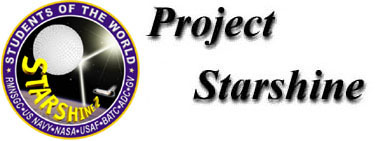
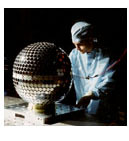
Michael A. Savell.
 
|
John Vasquez of the Naval Research
Laboratory prepares Starshine 1 for
vibration test. Photo by Michael A. Savell. |
|
Jon Boers of the Naval Space Command's final prediction was that Starshine 2 would flame out at 10:57 hours, UTC today at 48 degrees North latitude and 26.2 degrees west longitude. Harro Zimmer of Munich, Germany's final prediction was that Starshine 2 would flame out today at 11:02 hours UTC at 51.72 degrees North latitude and 3.24 degrees East longitude. It was not tracked by radar again after it passed over Flyingdales, UK on the previous orbit, so we can safely say that the Starshine 2 mission is now over. Click here for a plot of Starshine's orbital history throughout its life. Our sincere thanks to all the students, teachers, private individuals and organizations that helped make this experiment possible. The data from this mission will be used by the Naval Research Laboratory to make more accurate predictions of the orbital decay of other satellites, including Starshines 3, 4 and 5 and the International Space Station. Starshine 2 went out in a blaze of glory, yielding data on the most recent eruption on the sun right up to its final orbit, just as it has all the way through its brief, solar-storm-shortened life. The timing of this mission really couldn't have been any better. Just as a reminder, Mission Specialist Dan Tani successfully deployed Starshine 2 from Endeavor into its own orbit at 10:02:38 A.M. EST on Sunday, December 16, 2001. Click here for image.
It is now time to focus your attention on the Starshine 3 satellite, which is expected to flame out in September or October of 2002. For tips on how to maximize your chances of seeing the faint sunlight flashes from the tiny mirrors on the Starshine 3 satellite, Click here. Please be aware that the spin rate of the Starshine 3 satellite has decreased essentially to zero, now, so its sunlight flashes are very infrequent. In fact, you may see only one or two mirror flashes in an entire pass of the satellite across the sky. This expected decrease in rate has been caused by the spin-damping effect of eddy currents induced in the satellites' aluminum shells by their motion through the earth's magnetic field. |
Starshine 2 Update - December 11, 2001 |
Starshine 2 Update - December 5, 2001 |
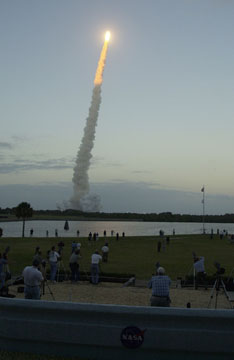 Click here: NASA/Kennedy Space Center Mutimedia Gallery |
Space Shuttle Endeavor lifted off from the Kennedy Space Center in Florida at
5:19 PM EST on December 5, 2001, carrying the Starshine 2 satellite in its cargo
bay. Astronaut Dan Tani will deploy Starshine 2 into its own orbit at 11:05 A.M.
EST on December 15.
Pre-Launch videos: Interview with Gil Moore, Starshine Program Manager |
Starshine 2 Update - November 27, 2001Launch preparations for Starshine 2 and all the other payloads on NASA Goddard's MACH-1 pallet have been successfully completed by Integration and Test Manager Bobby Patschke and his team. Here's a picture that Bobby took in Endeavor's cargo bay on November 26 of Phyllis Moore of Starshine Headquarters, making the traditional "STARSHINE GO!" pronouncement, after giving the satellite one last visual inspection. |
| The Starshine 2 student research satellite is on schedule for launch aboard Space Shuttle Endeavor on its STS-108 mission to the International Space Station on December 4, 2001. |
Here is Dr. Ruthan Lewis, MACH-1 Mission
Manager, together with her Integration and Test team, in front of their pallet prior to its
orbiter installation. Starshine 2's canister can be seen at the upper left corner of the pallet.
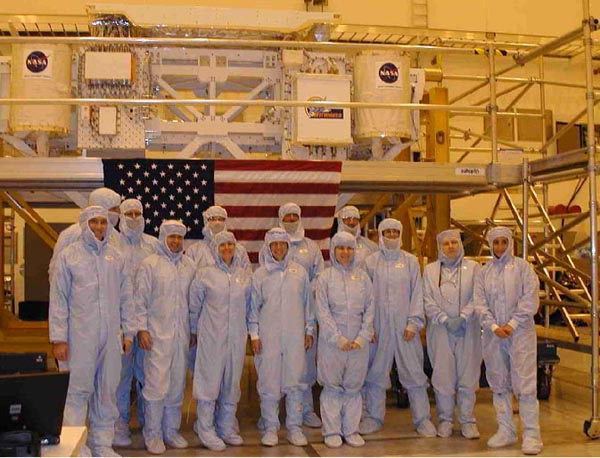
Here is Endeavor waiting on the pad for its scheduled liftoff on November 30, 2001.

As soon as Starshine 2 is deployed from Endeavor, the U.S. Space Command will start to track it and email its orbital elements to the Goddard Space Flight Center Orbital Information Group. Our friend, Chris Peat of Munich, Germany, will then access those elements and compute the specific times that the satellite will be visible in the twilight (pre-dawn or post- sunset) sky to any observer in the world between latitudes 62 degrees north and 62 degrees south. To learn when you can see Starshine 2 (clouds permitting), click here Heavens-Above.com and follow Chris's instructions. Don't forget to specify which Starshine satellite you want to see, because there will be two of them in orbit at the same time until Starshine 2 flames out sometime in the summer of 2002. Here is the new logo for the Starshine 2 mission. It was created by Praxis Corporation's Mary Helen Gregory, who has generously donated the designs of all our Starshine logos. Click here for more information about the logo and all the organizations and individuals that make the Starshine project possible .
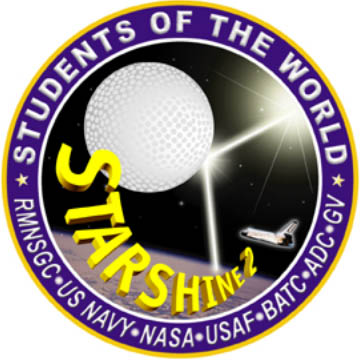 Click here for high resolution 300 DPI image (979 kb) |
Return to Project Starshine Home Page
Last Updated: April 30, 2002